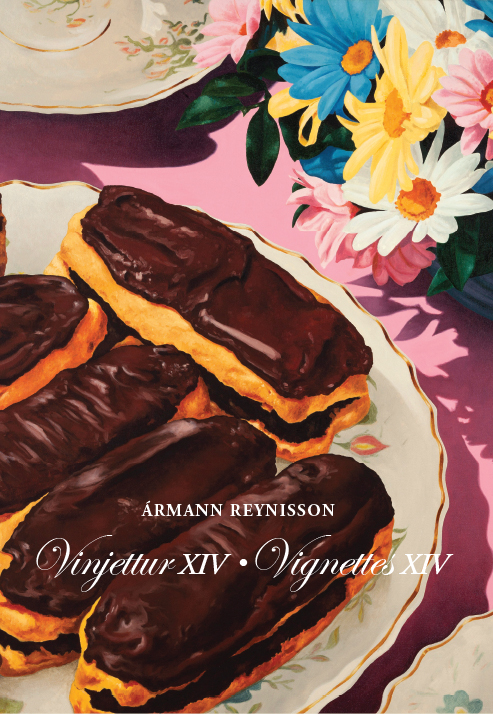Vignettes VIII
Ármann Reynisson deals with many aspects of life in the Faeroe Islands in these lively and visual narratives. Vignettes VIII also contains various tales and incidents from daily life in Iceland, the country´s landscape and even extends to a short portrait of Castro in Cuba. His vignettes have established a good reputation, provide excellent food for thought and are highly suited to be read aloud.
Chapters
Castro
During the cold war, all national leaders were seen in black and white terms by the media, whether they professed individualism or communism. It was thus no surprise that an unabashed Icelandic artist was struck with fear when he came to Cuba just before this naive view of world politics was toppled. There Castro and his fellows ruled after presiding over a proletariat revolution. He had been in power longer than most other leaders and survived a hundred assassination attempts and decades of economic sanctions imposed by the world’s most powerful nation.
The art exhibition
It is often a glorious occasion when an art exhibition opens and always reason for guests to join the artist in celebrating this success. He has worked day and night to complete his paintings and has spent no less time on arranging them in the gallery. Invitations are sent out to art lovers and potential buyers and, of course, to the media who provide an essential liaison between the event and the general public. The situation is such that a young and promising artist, who is good at promoting his own image, prepares a major show in a well known gallery. He plans to use the occasion to become a huge success. He has finished all the preparations and hung up his paintings shortly before the guests are due to arrive and decides to go home, take a bath and change clothes – after all, it is expected that people look their best when then there is so much at stake.
The Faeroe Islands
The Faeroes look like weather-beaten mountain tops as they rise up out of the Atlantic between two continents. Many of the islands are connected by a series of tunnels, alive with traffic moving between the various towns and villages. The mountains are rounded and soft in form after the endless rubbing of the wind. Gushing rivers pour down the slopes and look like shining glass in the landscape. It is interesting that this also applies to the weather-beaten clouds that glide over the islands almost daily. The islands also take the form of all kinds of creatures, such as a crouching lion, a horse lying down or a sheep grazing. Along the rocky coastlines, barely protected from the tides, snuggle scattered villages in sandy bays and inlets, the houses with their own distinctive style. There are also exquisitely built dry stone walls, winding like serpents along the slopes and into the villages.
The Nykur
In a lake on Sandøy there lives a nykur, man above the waist and below a bull with a thick tail. It keeps itself below the surface of the water, except when it has work to do on land, usually when there is not a soul abroad. The creature has no name and has little in common with man or beast. Those who secure his service are lucky indeed because he does the work of many men.
Courage
On the southern coast of Suðurøy, where waves fall against the shore, there are some shapely sand dunes and a grassy bay. The place is surrounded by mountains that jut out rocky into the sea on each flank. There is a small lowland area along the shore where lies Fámjin, a peaceful town with a pretty church at its centre. Above the church a narrow waterfall falls from a brimful basin between the rocks in the hillside. On the northern wall of the Lord’s house, hangs a carefully made national treasure. It is a flag, a red cross bordered with light blue on a white background that was first flown as the Faeroese national banner.
Rannva
Most young people in the Faeroes dream of coming to the Ólavsøku festival, held in late summer in Tórshavn with dance and song – a time when the whole town is happy. That applies as well to a lively young girl called Rannva, a farmer’s daughter who lives in Skúvoy with her parents where nothing much happens. The big moment arrives and she goes to the festival in all her finery, all smiles, sailing to the capital by boat with her people. Everyone is aware of her sensuality, especially the men and irrespective of age.
Gold
The lust for gold has haunted mankind since it was first discovered. Even some animals and magical creatures lie on and thrive on the good metal. A thirst for gleaming gold will probably never abate. In a cave in a good place in the Faeroe Islands, a female troll lives and thrives. What keeps her alive is the gold she can gather by hook or by crook since she is not subject to the laws and regulations of society. The troll nourishes and rests herself on the precious metal that extends her life far beyond the years of any human. So, the centuries pass and no one dares to confront her or touch her highly desirable treasure.
Little Soviet
The Soviet Union rises and resoundingly falls in the space of one lifetime. Totalitarianism and the protection of the interests of a chosen élite so undermine its ambitions of world power that there is no longer any need to wage war against it to topple its inner corruption. In the wider scheme of things, it is not long-lived. Indeed, history shows that empires have one thing in common – they rise and then they fall.
Feeling the rub
The large cities of the world have their plusses and their minuses. Like magnets, they attract people looking for a golden opportunity or travellers who see them as heavenly. The conclusions people reach about them depends on the ultimate success of their pursuits.
The composer
Composers are endowed with an ability to hear music that has not yet been written down in notes. Yet after it has been transcribed to paper, whoever is able to read music can hear it, musicians can play it and singers sing it for audiences. Saint Cecilia has inspired many to write. Some had an inherent gift and others had to spend many years learning to be composers of the noble art. However, only a select few enjoyed the fruits of their labours.
The death of the poet
After a prosperous and long but stormy life, the poet died quite suddenly. He began his writing career unexpectedly in his mature years and soon reached his prime at a time when most of his peers had been forsaken by the muse. At the end of a fortunate upbringing and education the man makes a magnificent input into the life of the nation when he returns from his studies abroad.



